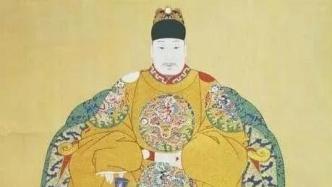
Appreciating delicate and elegant porcelain pieces was one of the few ways that the Qing emperors Yongzheng and Qianlong could find solace and relaxation amidst their busy and rigorous political lives. These pieces were either inspired by Song Dynasty aesthetics, boasting exquisite form and color; or they used porcelain as a base to transplant the refined and elegant literati paintings into their small space; or they incorporated calligraphy and painting into teaware for the enjoyment of tea; and some even depicted nature itself on porcelain, creating lifelike replicas. The colors were understated and elegant, the polychrome porcelain refreshing and delightful.
The Paper learned that the "Exquisite" special auction presented by China Guardian in its 2025 Autumn Auction mainly features exquisite small pieces that can be held in the palm of your hand, showcasing the infinite charm within a small space. This special auction brings together imperial porcelain, which reflects the appearance of imperial porcelain during the Yongzheng and Qianlong reigns of the Qing Dynasty. It reveals imperial power, refined taste, antiquarianism, and innovation, all of which permeated the imperial porcelain production during the Yongzheng and Qianlong reigns of the Qing Dynasty.
Learn from the past without being bound by it.
From the Northern Song Dynasty, with the strong support and promotion of epigraphy, "making artifacts in accordance with ancient styles" became fashionable. From the Southern Song to the Ming Dynasty, as literati enjoyed leisurely appreciation, the value and cultural connotations of ancient objects became increasingly rich. "Learning from the ancients without being bound by them" is an important key to understanding the design philosophy of Qing Dynasty court art.
This "Exquisite" special auction features many works that emulate previous dynasties, especially the imitations by the Yongzheng Emperor that are almost indistinguishable from the originals, such as the "Qing Yongzheng Imitation Chenghua Doucai Chrysanthemum Spray Cup", the "Qing Yongzheng Imitation Chenghua Doucai Ruyi Lingzhi Pattern Small Plate", and the "Qing Yongzheng Imitation Guan Glazed Paper Hammer Vase".

A Qing Dynasty Yongzheng period imitation Chenghua doucai cup with chrysanthemum spray design.
Chenghua doucai porcelain is unparalleled throughout history, not only pioneering a new era of polychrome porcelain but also exerting a profound influence. The Kangxi, Yongzheng, and Qianlong emperors all highly praised Chenghua doucai, with Yongzheng's imitations being particularly convincing, leading to the saying, "For Ming dynasty porcelain, look to Chenghua; for Qing dynasty porcelain, look to Yongzheng." Yongzheng doucai can be divided into two categories: one is a style created by the emperor himself, and the other is an imitation of Chenghua works, exquisitely crafted and lifelike, yet incorporating his own unique style. The "Qing Dynasty Yongzheng Imitation Chenghua Doucai Chrysanthemum Spray Pattern Cup" belongs to the latter category.
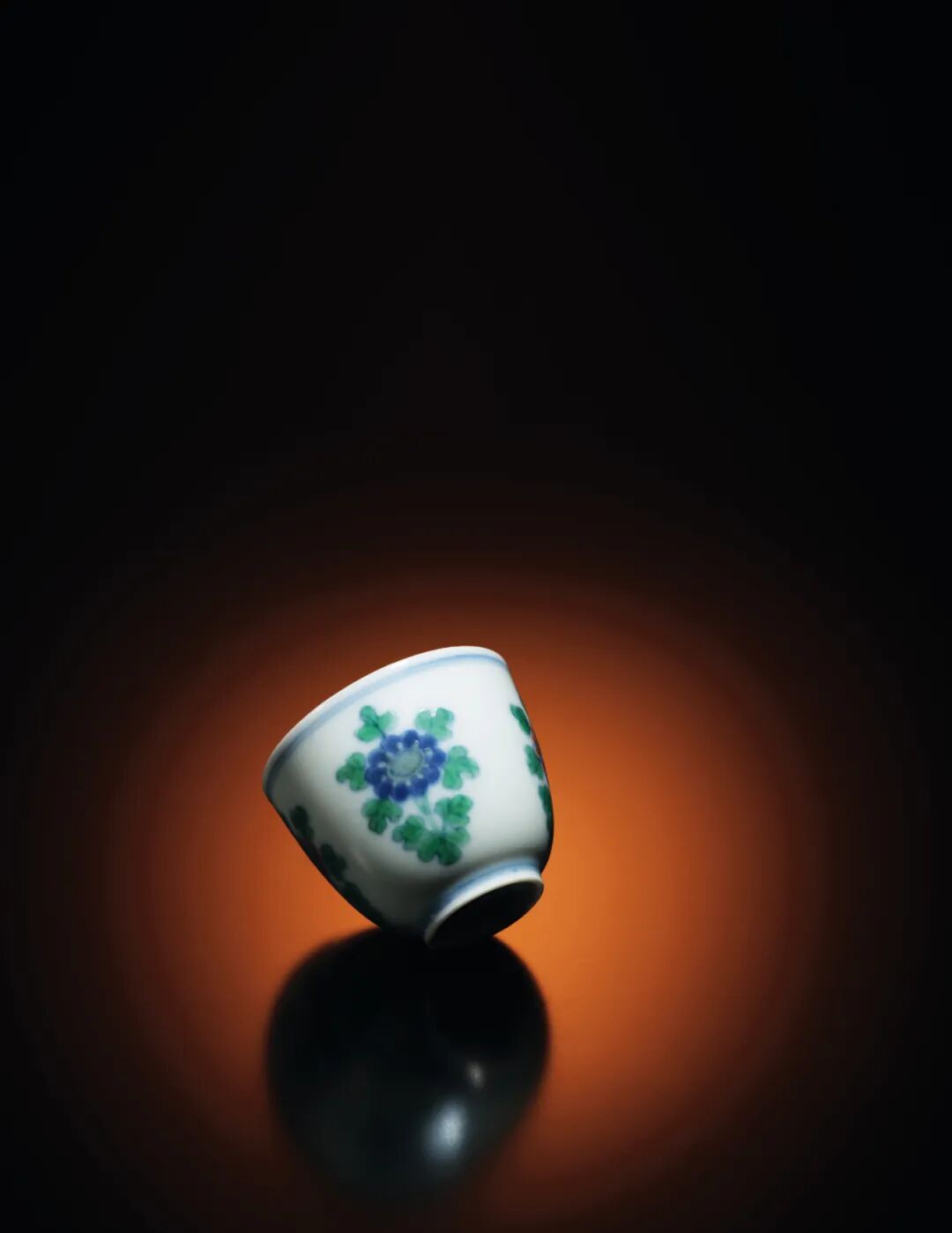
Qing Dynasty Yongzheng period imitation Chenghua doucai chrysanthemum spray cup
The small cup has a wide mouth, a deep, curved belly, and gradually tapers inward from the rim to the base. The exterior is decorated with four groups of chrysanthemum branches, each flower supported by eight leaves arranged in an arching formation. The leaves are spread out, displaying an upward-reaching posture, complementing the delicate shape of the cup. The colors are bright and elegant. The base bears a six-character inscription within a double square frame: "Made in the Chenghua Reign of the Great Ming Dynasty."
Emperor Yongzheng was a connoisseur of flower arrangement, possessing refined taste and a profound appreciation for the beauty of autumn chrysanthemums, setting unique standards for their elegance. Tao Yuanming's love of chrysanthemums made them a symbol of the noble and detached hermit in the literati tradition. The Palace Museum's album of paintings, "Emperor Yongzheng Enjoying Life," includes a picture of Emperor Yongzheng dressed in Hanfu, impersonating Tao Yuanming, admiring chrysanthemums by the eastern fence.
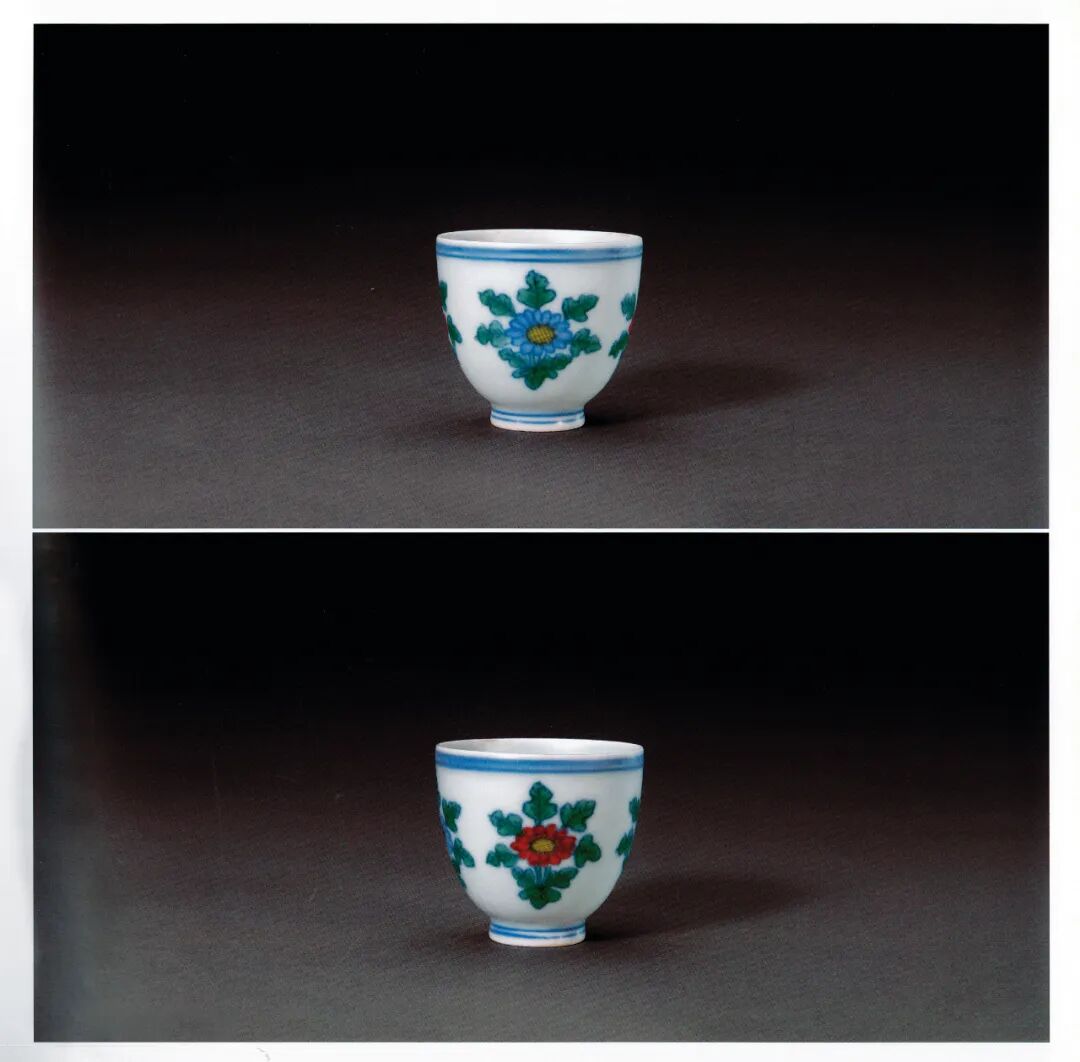
Chenghua works in the collection of the Palace Museum
This piece is a prototype from the Chenghua period, and like the Chenghua grape-patterned cup, it is a famous doucai (enamel overglaze) piece. They are of the same type and are housed in the Palace Museum. A pair of similar Kangxi imitations of Chenghua pieces were auctioned at Sotheby's Hong Kong in 2012, while similar Yongzheng imitations of Chenghua pieces are even rarer.

Old photo of Mr. Yan Shengbo
This work was formerly in the collection of the Yan Shengbo family. Mr. Yan Shengbo (1910-1994), courtesy name Yanjun, studio name Baomengtang, was a native of Nanchang, Jiangxi Province, and a modern connoisseur of calligraphy and painting. He was a close friend of Zhang Daqian, and they traveled together to Japan and Switzerland. He frequently exchanged poems and calligraphy with fellow art enthusiasts such as Pu Xinyu and Wang Jiqian. In 1949, Mr. Yan Shengbo moved to Hong Kong, where he focused on collecting antiques and calligraphy and paintings. In December 1979, he, along with Ge Shiqiao, Luo Guixiang, Yang Yongde, Zhang Zongxian, Qu Guiliu, Liang Yi, Chen Hong, and others, formed the "Qiu Zhi Ya Ji" (Seeking Knowledge Gathering), a renowned group of collectors in Hong Kong.

A small doucai dish with ruyi and lingzhi patterns, made during the Yongzheng period of the Qing dynasty, imitating the style of the Chenghua period.
Another piece, a "Qing Dynasty Yongzheng period imitation Chenghua doucai ruyi lingzhi pattern small plate with a folded waist," is also a classic work of the Yongzheng imperial kiln in imitating Chenghua kiln works.
With a wide mouth, folded waist, and ring foot, this piece is simple and elegant, its doucai (enamel overglaze) decoration refreshing and pleasing to the eye. Both the interior and exterior are decorated with doucai, the exterior featuring five lingzhi (reishi mushroom) patterns, while the center is adorned with a six-petaled ruyi (auspicious symbolism) design, symbolizing "harmony and good fortune." This "Ruyi Lingzhi Pattern Folded-Waist Small Dish" is a Yongzheng doucai piece imitating Chenghua doucai, a classic example of official imitation of official doucai. The Chenghua official kiln doucai folded-waist dish was already admired during the Jiajing period of the Ming Dynasty, demonstrating the high regard in which Chenghua porcelain was held by the ancients.
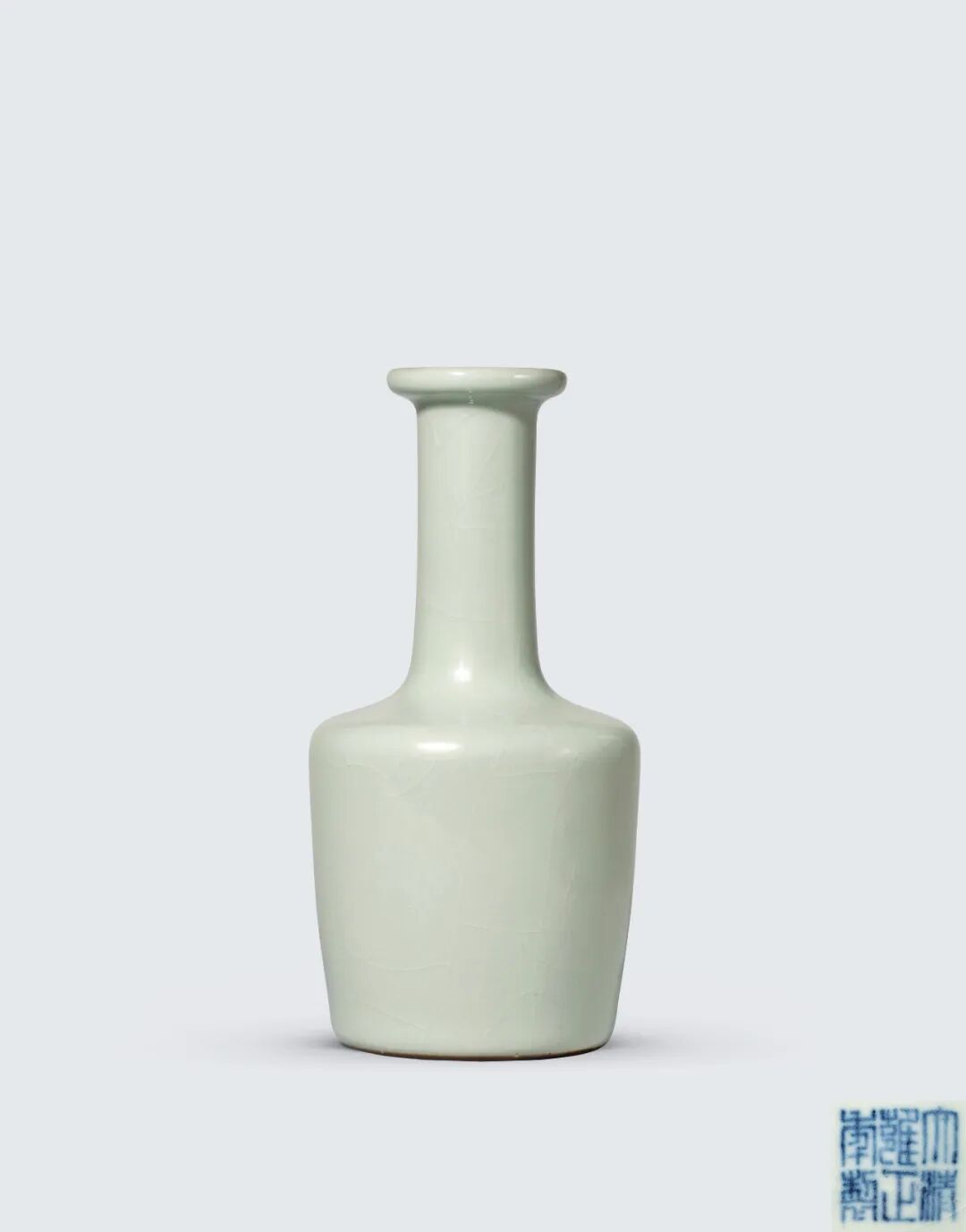
Qing Dynasty Yongzheng period imitation official glaze mallet-shaped vase
This "Qing Dynasty Yongzheng Period Imitation Guan Glazed Mallet-Shaped Vase" has a flared mouth, straight neck, angled shoulders, cylindrical body, and inward-curving base with a recessed foot. The entire body is covered in an imitation Guan glaze, the surface of which is elegant and thick, with naturally flowing crackles, exuding an antique charm reminiscent of Song Dynasty artifacts. The base bears a six-character, three-line seal script mark in underglaze blue reading "Made in the Yongzheng Reign of the Great Qing Dynasty."
As one of the five famous kilns of the Song Dynasty, the Guan kiln was highly favored by the Qing Dynasty imperial family. By the Yongzheng and Qianlong periods of the Qing Dynasty, the emperors were no longer content with simply appreciating ancient Guan kiln wares; they also desired to revive these classic works. In the "Record of Pottery Production" by Tang Ying in the thirteenth year of Yongzheng's reign (1735), the imperial kiln's imitation of antique styles and the addition of new glaze varieties included "Imitation of Song Dynasty Iron-Bone Da Guan Glaze." The inscription records that "Imitation of Iron-Bone Da Guan Glaze includes three colors: moon white, powder blue, and dark green, all imitating the colors of Song Dynasty wares." Extant Song Dynasty mallet-shaped vases include works from the Ru, Guan, and Longquan kilns; this piece was likely modeled after Song Dynasty wares.
The mallet-shaped vase originated from glass vessels in West Asia. It was introduced to the Central Plains at the end of the Northern Song Dynasty and later modified into porcelain, becoming a classic vase shape of the Song Dynasty. In terms of its function, it was primarily used as a flower vase throughout history. For example, Gao Lian of the Ming Dynasty recorded in his "Three Discourses on Vase Flowers" that "(for flower arrangements in the study) vases should be short and small, such as the Guan Ge vase, mallet-shaped vase, and goose-neck vase... all are suitable for flower arrangement."
Innovate
Innovation rooted in the pursuit of antiquity can be considered the most exquisite aspect of the Qing Dynasty court. The introduction of new techniques and materials, the borrowing of styles from different art forms, and the top-down artistic creation constituted a magnificent artistic landscape. Several outstanding innovative works, such as the "Qing Dynasty Yongzheng period famille rose hibiscus and dragonfly plate," the "Qing Dynasty Yongzheng period famille rose tea bowl with immortals and figures," and the "Qing Dynasty Qianlong period famille rose small vase with a continuous succession of imperial examinations," will be presented in this "Exquisite" special auction.
The famille rose porcelain of the Qing Dynasty imperial kilns originated in the late Kangxi period. It was a new product created by incorporating enamel techniques into the base of wucai (five-color) porcelain. During the Yongzheng period, the famille rose technique reached its peak, with exquisite craftsmanship that has been passed down through the ages.
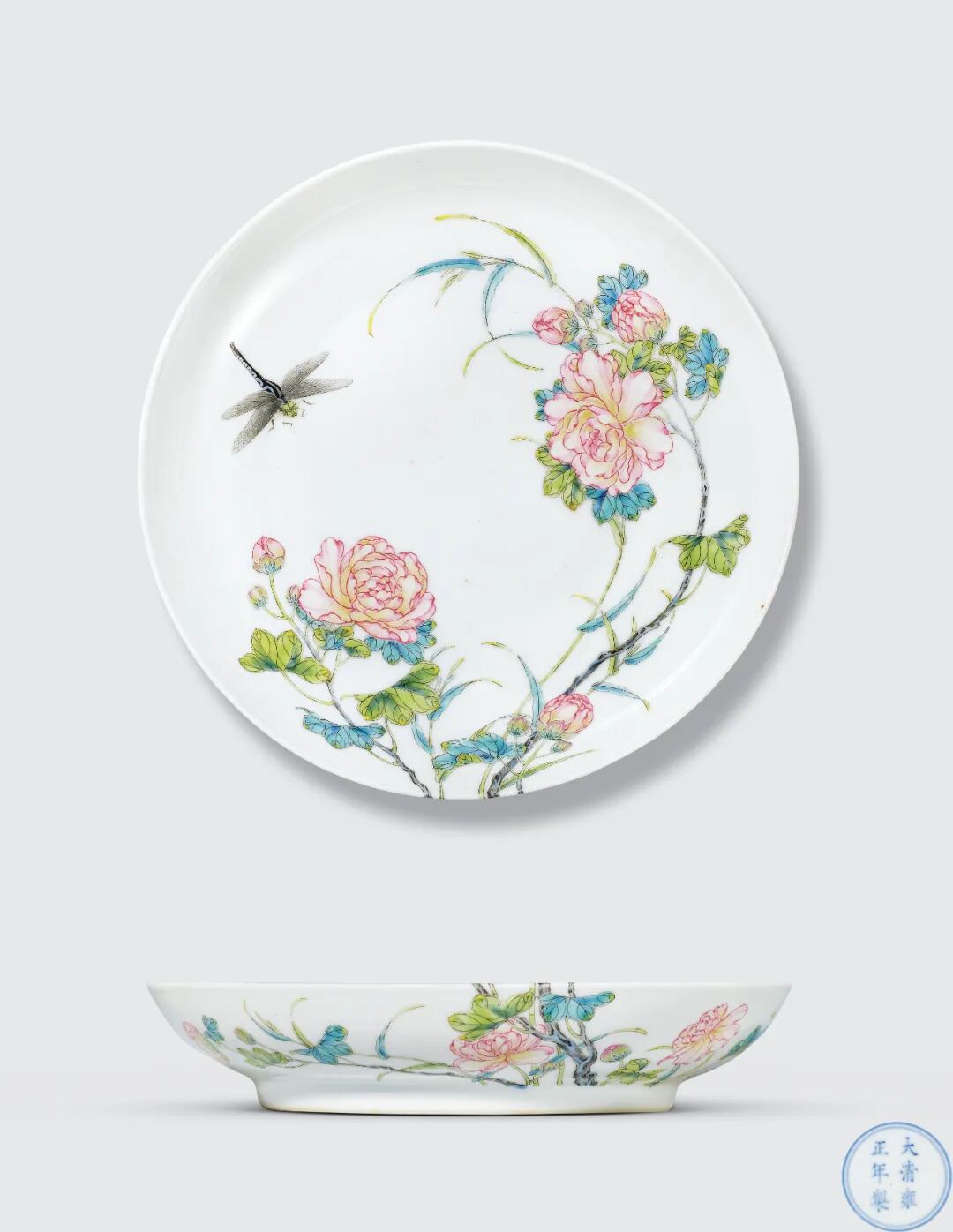
Qing Dynasty, Yongzheng Period, Famille Rose Dish with Hibiscus and Dragonfly Design
"A Qing Dynasty Yongzheng Period Famille Rose Dish with Hibiscus and Dragonfly Design" depicts a cluster of hibiscus interspersed with a few wisps of reeds, beginning at the outer edge of the base. The flowers and leaves are lush and delicate, extending over the branches. The hibiscus blossoms are vibrant and charming, with a few buds appearing shyly about to bloom. A dragonfly flutters its wings, seemingly about to alight on the flowers. The brushstrokes are delicate and clear, with every detail of the petals, branches, leaves, the texture of the dragonfly's wings, and the barbs on its claws rendered with exquisite precision. Hibiscus flowers are known for their varied shades and intensities, earning them the nickname "changing three times a day." The base of the flowers is a glassy white, with a slight yellowish-green tinge near the center. Transparent veins are carved into the petals with a pointed tool along the direction of their extension, creating a lifelike effect that perfectly embodies the hibiscus's reputation for "changing three times a day" due to its varied shades and intensities.
The brilliance of this piece's layout lies in the use of the "overflowing branch" technique. Also known as "overflowing wall," this technique connects the inner and outer walls of the bowl or plate, with the design extending from the outer wall across the rim to the center, creating a harmonious blend of independent and unified designs. Pieces employing this method are invariably of exceptional quality.
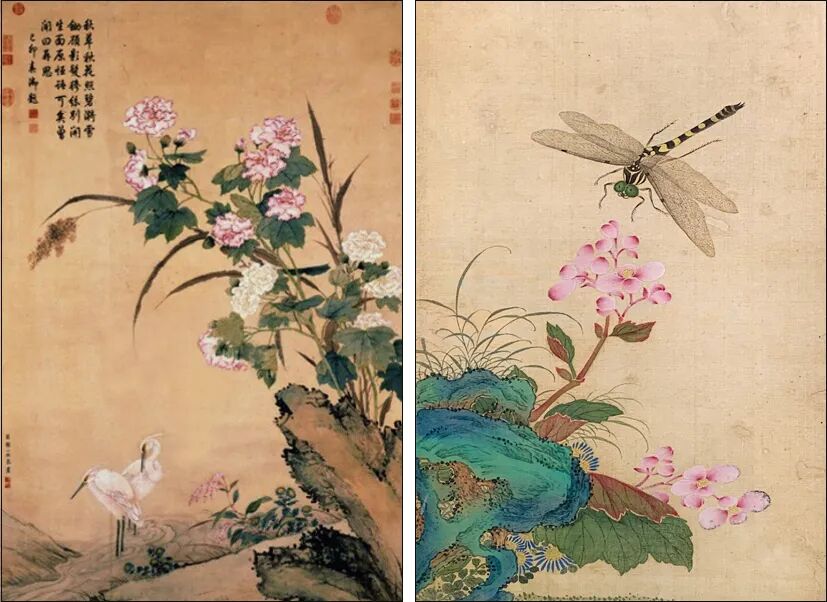
Left: Detail of Zou Yigui's "Hibiscus and Two Egrets"; Right: Detail of Jiang Tingxi's "Album of Flowers, Insects and Plants" (Collection of Shenyang Palace Museum).
Judging from the painting style, it must have been created by court painters Jiang Tingxi and Zou Yigui, both students of Yun Shouping. They emphasized both realistic and expressive styles, resulting in an elegant and refined brushwork. Qin Zuyong, in his *Tongyin Lunhua* (On Painting under the Shade of the Paulownia Tree), commented that Zou Yigui's style of creating texture with heavy powder and rendering with light colors is strikingly similar to this piece, suggesting a strong connection between their powder painting techniques and Zou's. For example, the hibiscus flowers in Zou Yigui's *Hibiscus and Egret* are painted in the same way as in this piece, and the dragonfly in one of Jiang Tingxi's *Album of Flowers, Insects, and Grasses* is identical to this work. The seamless collaboration between court painters and master craftsmen of the imperial kiln ultimately resulted in this exquisite and beautiful famille rose porcelain piece, resembling a miniature realistic painting.
This item comes with wooden packaging inscribed "A Pair of Yongzheng Famille Rose Hibiscus Flower Plates." The inner lining of the packaging box is made of newspapers from the Republican era, showing the Kailuan Mining Bureau, Tianjin Shujie Street, and various Japanese characters. This indicates that this item was a treasured possession of a retired gentleman in Tianjin during the Republican era, and its survival to this day after the ravages of war is truly remarkable.
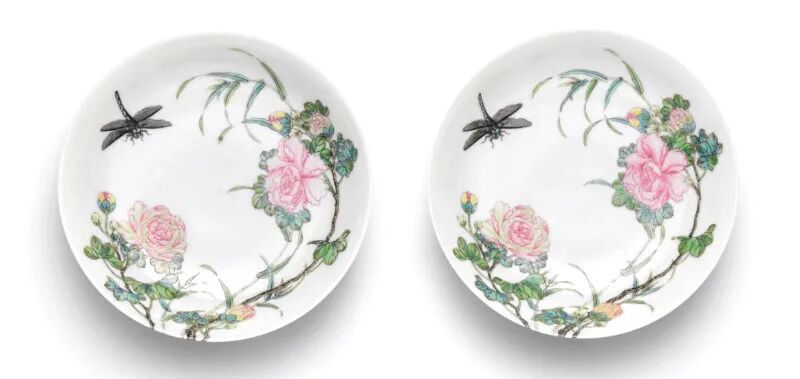
Meiyintang Collection
Similar compositions to this porcelain piece have been seen in public and private collections, including the Meiyintang Collection and the Pamer Family Collection.
During the Yongzheng reign, the precision and richness of porcelain painting surpassed those of previous dynasties. In particular, the famille rose enamels, which had begun to take shape in the late Kangxi period, reached their zenith during the Yongzheng era. Their compositions emphasized depth and layering, highlighting the theme and possessing a strong calligraphic and pictorial quality. The figures and patterns were imbued with literati charm and were remarkably lifelike. This reflects the Yongzheng Emperor's refined and delicate aesthetic pursuits.
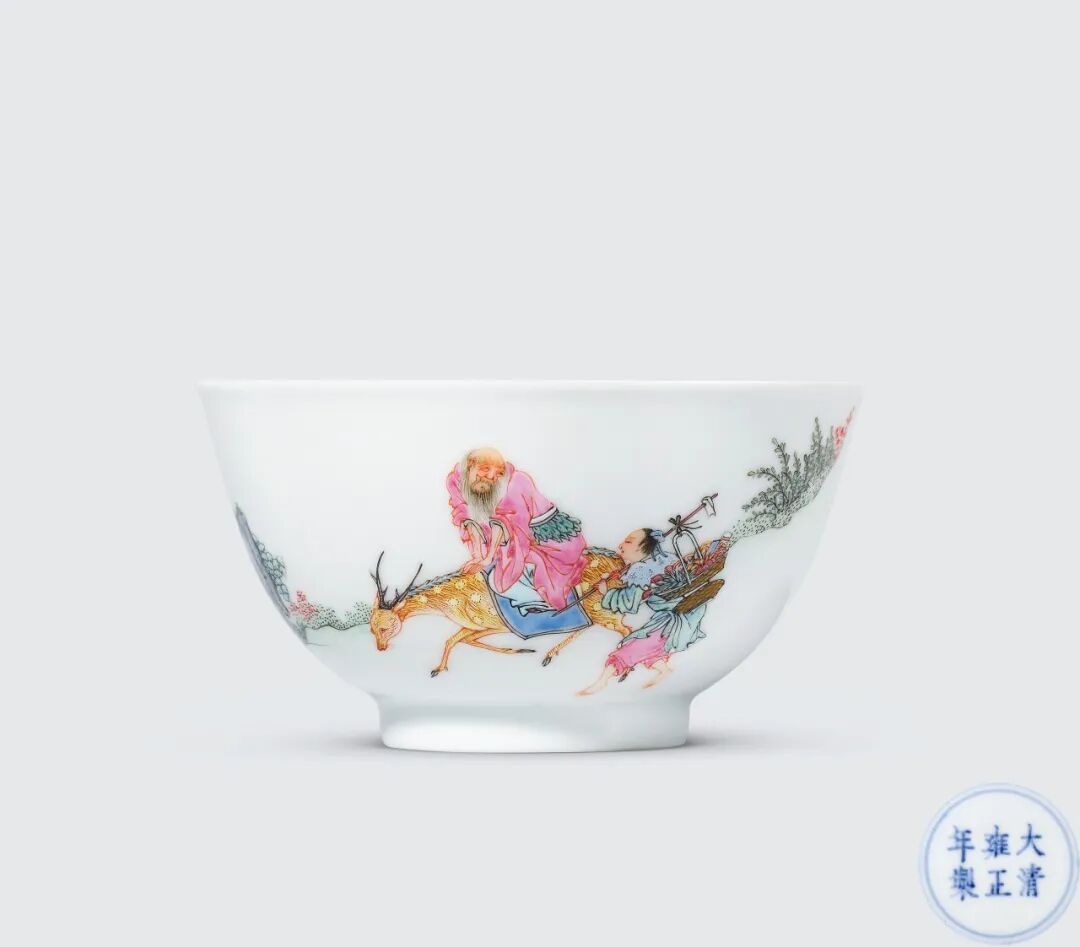
Qing Dynasty, Yongzheng Period, Famille Rose Tea Cake with Immortal Figures
The outer wall of the "Qing Dynasty Yongzheng period famille rose tea round with immortal figures and deer" is painted with an immortal riding a deer. The mountains are beautiful and lush with morning mist and evening haze. The white-haired immortal rides a deer, wearing a pink robe and a feather skirt around his waist. His hands are placed on the deer's back, and his expression is serene. The auspicious deer is lying down. Behind him, a barefoot man carries a hoe and a flower basket on his back. The basket is filled with lingzhi mushrooms, bidding farewell to the immortal.

Complete pattern
On the other side, layers of rocks are meticulously outlined, separated by fine horizontal strokes. The rocks at both ends have a subtle bluish-gray tint, with bluish-gray pigments layered on top of the short strokes. The pigments are rendered with delicate naturalness, creating a fascinating effect that highlights the three-dimensional texture and interplay of light and shadow on the rocks. Grass and trees sprout behind the rocks, and red dots dot the ground on both sides, resulting in an overall elegant and refined artistic effect.

Collections of the Palace Museum

Shanghai Museum Collection
According to a representative from the porcelain department of China Guardian Auctions, similar marks to this piece are quite rare, and its calligraphic style suggests it is an early Yongzheng period work. A similar mark can be found in the Palace Museum's collection of a "Yongzheng Famille Rose Plum Vase with Figures and Deer Design," whose subject matter is extremely similar to this piece, suggesting they may have been made around the same time. Furthermore, a comparison with the "Yongzheng Famille Rose Brush Pot with Spring Night Banquet in Peach and Plum Garden" in the Shanghai Museum reveals a similar style in the inscription. Additionally, the Shanghai Museum also possesses a "Yongzheng Ink Landscape Brush Pot," whose inscription is similar to this piece, its composition and brushwork emulating the landscapes of the Four Wangs of the early Qing dynasty, exhibiting a strong literati painting style. By comparing the marks, compositions, and decorative details of several porcelain pieces in the collections of the Palace Museum and the Shanghai Museum, it is easy to see that those bearing such Yongzheng blue and white marks are mostly found on pieces from the Yongzheng imperial kilns that have a strong literati character. They are different from the general standardized official kiln porcelain, or they are works produced under the instruction of Emperor Yongzheng specifically for his use and enjoyment, and are of great value for collection and research.
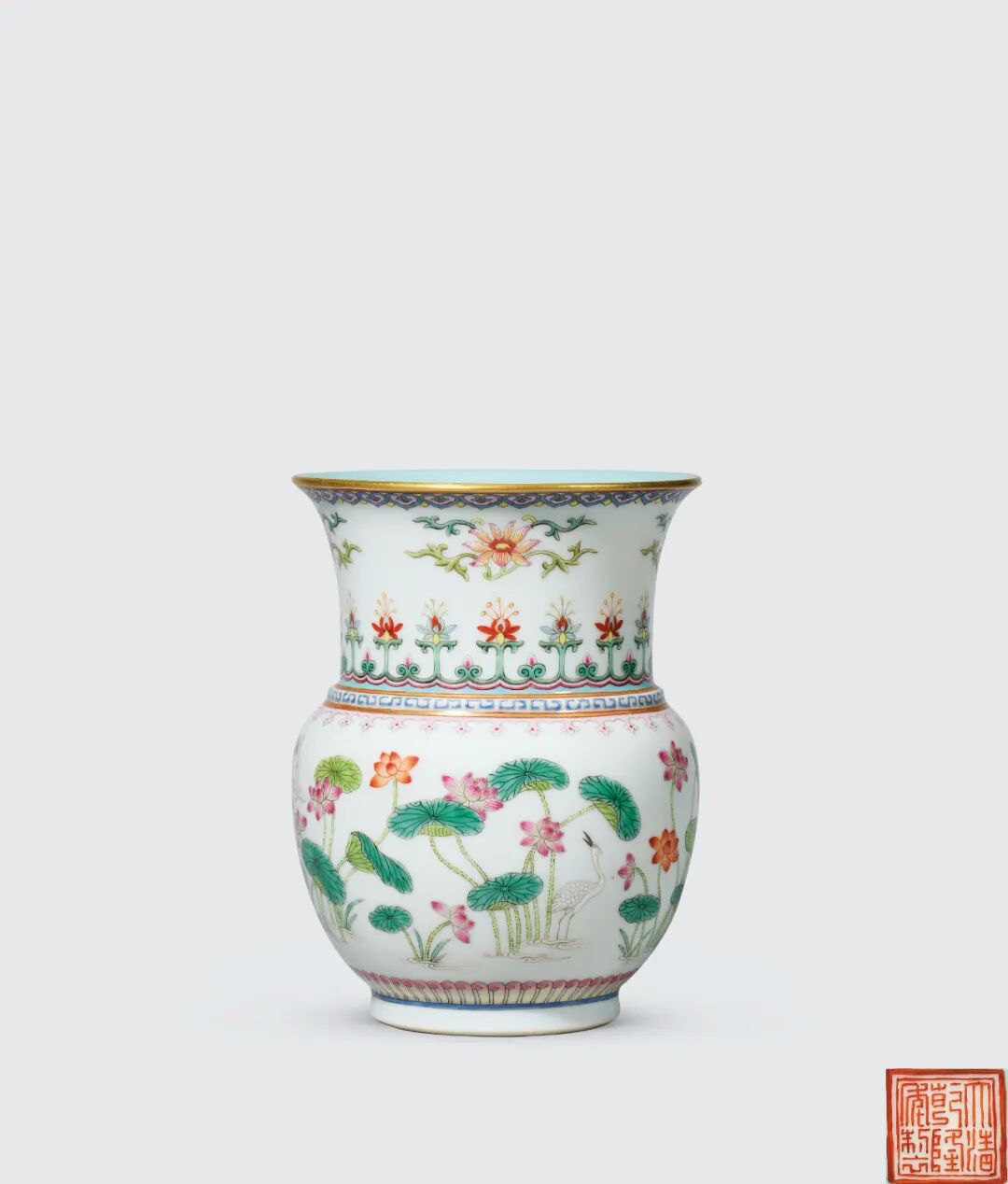
A small vase with the motif of "Continuous Success in Imperial Examinations" from the Qianlong period of the Qing Dynasty.
The rim of the vase is gilded, and the neck is adorned with various patterns from top to bottom, the colors rich yet not overly elaborate. The body is decorated with a continuous scene of a lotus pond and egrets in famille rose enamels. In the water, tender green leaf stalks and flower stems rise, supporting large lotus leaves, vibrant lotus blossoms, and plump, seed-filled lotus pods, swaying gracefully. Four egrets, each with full, white plumage, are depicted in different poses, their postures relaxed and ethereal, presenting a tranquil and beautiful summer lotus pond scene.
The word "egret" (鹭) is a homophone for "road" (路), and "lotus" (莲) is a homophone for "continuous" (连). In the old imperial examinations, passing the exams consecutively was called "continuous success" (连科). The pattern of egrets and lotus flowers is called "continuous success" (一路连科), which is a blessing for candidates taking the imperial examinations, wishing them success in passing all three levels of the exams and a smooth official career.
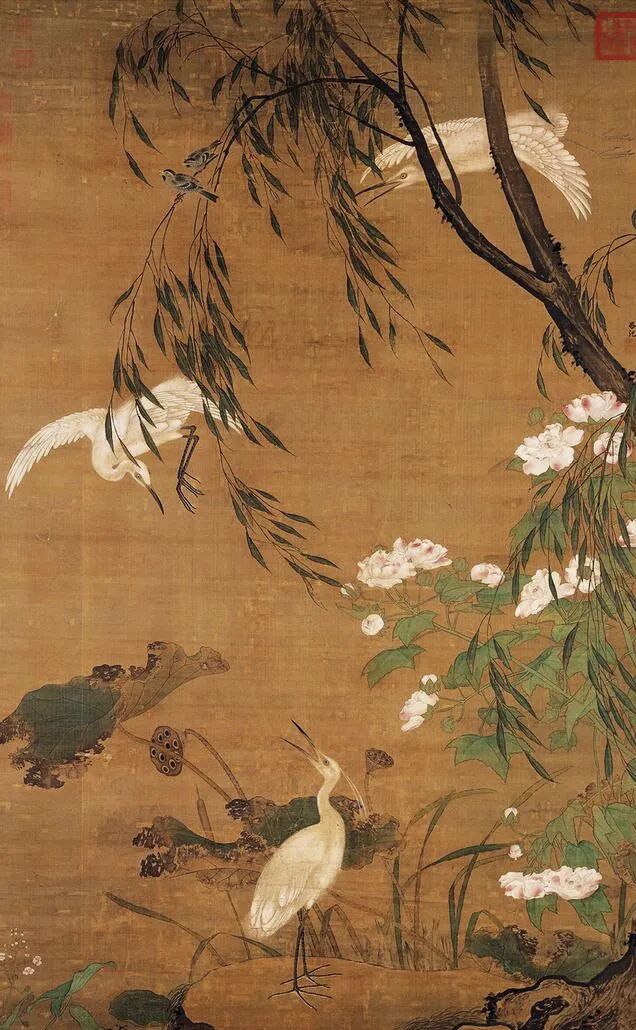
Partial view of Lü Ji's "Autumn Egret and Hibiscus"
Porcelain pieces decorated with the "continuous success in imperial examinations" motif are rare during the Qianlong period. The production of such unique pictorial objects required court painters to first create designs, which were then approved by the emperor before being sent to the imperial kilns for firing. The inspiration for these designs often came from paintings in the Qing court collection. The movements and expressions of the egrets in the Ming dynasty painter Lü Ji's "Autumn Egrets and Hibiscus" may serve as the model for this piece.
Imperial interest
Understanding the intention behind the creation of these artifacts is essential to deeply exploring their underlying meaning. In 1713, the 52nd year of the Kangxi Emperor's reign, the emperor celebrated his 60th birthday. The imperial court and the surrounding area spared no effort in preparations for this occasion, and the porcelain pieces associated with this event can only be better understood in the context of this historical period. Similarly, understanding the series of imperial tea wares that arose in response to the more than ten poems by the Qianlong Emperor about pre-rain Longjing tea is crucial. The fourteen wall vases on the walls of the Sanxi Hall in the West Warm Pavilion of the Yangxin Hall also reflect the Qianlong Emperor's interest in "accompanying his verses and appreciating the beauty along the way."

A large polychrome plate with the design of Magu offering longevity flowers, dated to the Kangxi period of the Qing Dynasty, bearing the inscription "May you live ten thousand years."
The plate has a folded rim, an arched belly, and a ring foot. It is covered in a transparent glaze and decorated with polychrome enamels. The rim is painted with a brocade pattern of plum blossoms, with the four characters "万寿无疆" (May you live ten thousand years) in the center. The center of the plate depicts Magu offering longevity cakes, with Magu holding a ruyi scepter, followed by maids holding peaches, and a mythical beast pulling a cart carrying a pot of lingzhi mushrooms. The base has a double blue-and-white circle enclosing the six-character inscription "大清康熙年制" (Made in the Kangxi Reign of the Great Qing Dynasty) in regular script. This type of plate with "万寿无疆" border decoration is also seen with flower and bird designs. Four different versions of this Magu offering longevity cake design are found: one depicting only Magu and her maids holding wine pots and cups; another showing Magu holding a gourd and a maid carrying a flower basket; a third showing a maid holding lingzhi mushrooms and a deer pulling longevity wine; and the fourth being this particular piece. Of these variations, this one is perhaps the rarest.
Another unique aspect of the illustrations on this item is that while the common depiction of Magu offering longevity gifts often features auspicious deer, the mythical beast depicted on this item resembles the "Jiao" described in the *Classic of Mountains and Seas*. According to the *Classic of Mountains and Seas*, "Its horns are like those of an ox, and its name is Jiao. Its cry is like that of a barking dog; its appearance foretells a great harvest in the country." The replacement of the deer with Jiao on this item may be intended as a prayer for national blessings.
Based on the motif of Magu offering longevity gifts and the inscription "May you live ten thousand years," this piece is believed to have been used in court birthday banquets, and is very likely a piece specially commissioned by the court for Emperor Kangxi's sixtieth birthday. In the fifty-second year of Kangxi's reign (1713), Emperor Kangxi celebrated his sixtieth birthday. The court and the public spared no effort in preparations for this grand occasion. The year prior, Lang Tingji commissioned the kilns in Jiangxi to meticulously produce a batch of auspicious and high-quality porcelain for imperial use. The *Tao Ya* records: "For Emperor Renzong's sixtieth birthday, many porcelain pieces were made. Plates, bowls, dishes, cups, flowers, birds, insects, and fish—almost everything was beautifully presented." Their high quality and auspicious symbolism make them highly valuable.

A large doucai (enamel overglaze) plate with a birthday design from the Kangxi period of the Qing Dynasty.
This piece has a wide mouth, shallow, curved belly, and a ring foot. It is decorated inside and out with doucai (enamel overglaze) enamel. The center of the plate features a "Longevity Celebration" design composed of a blue-and-white longevity character, doucai peaches, and cranes. The interlocking patterns clearly define the theme, showcasing the traditional motif of cranes offering longevity blessings with exquisite detail using highly innovative decorative techniques. The inner wall is decorated with interlaced five-colored cloud patterns interspersed with round longevity characters and peaches. The outer wall is painted with a "Lingzhi Immortals Celebrating Longevity" auspicious pattern composed of bamboo, lingzhi fungus, and longevity stones. The interior and exterior complement each other, highlighting the theme of longevity. The base bears a six-character double-line regular script mark in underglaze blue: "Made in the Kangxi Reign of the Great Qing Dynasty."
This piece features a refined and elegant painting style, with vibrant colors, meticulous detail, and distinct layers, presenting a fresh and graceful artistic appearance. It is a masterpiece among Kangxi doucai porcelain. As Xu Zhiheng praised in his "Yinliuzhai Shuoci," "Doucai porcelain reached its zenith during the Kangxi and Yongzheng periods. Whether depicting figures, flowers, birds, or animals, each piece is uniquely radiant and charmingly beautiful." Its auspicious imagery, exquisite body and glaze, masterful painting, and elegant inscription all demonstrate the high level of maturity in doucai firing techniques during the Kangxi era.
Furthermore, based on the themes of birthday celebrations, family reunions, and the immortals celebrating longevity on this piece, it is speculated that it was used in court birthday banquets, and it is very likely that it was a porcelain piece specially made by the court for Emperor Kangxi's sixtieth birthday.
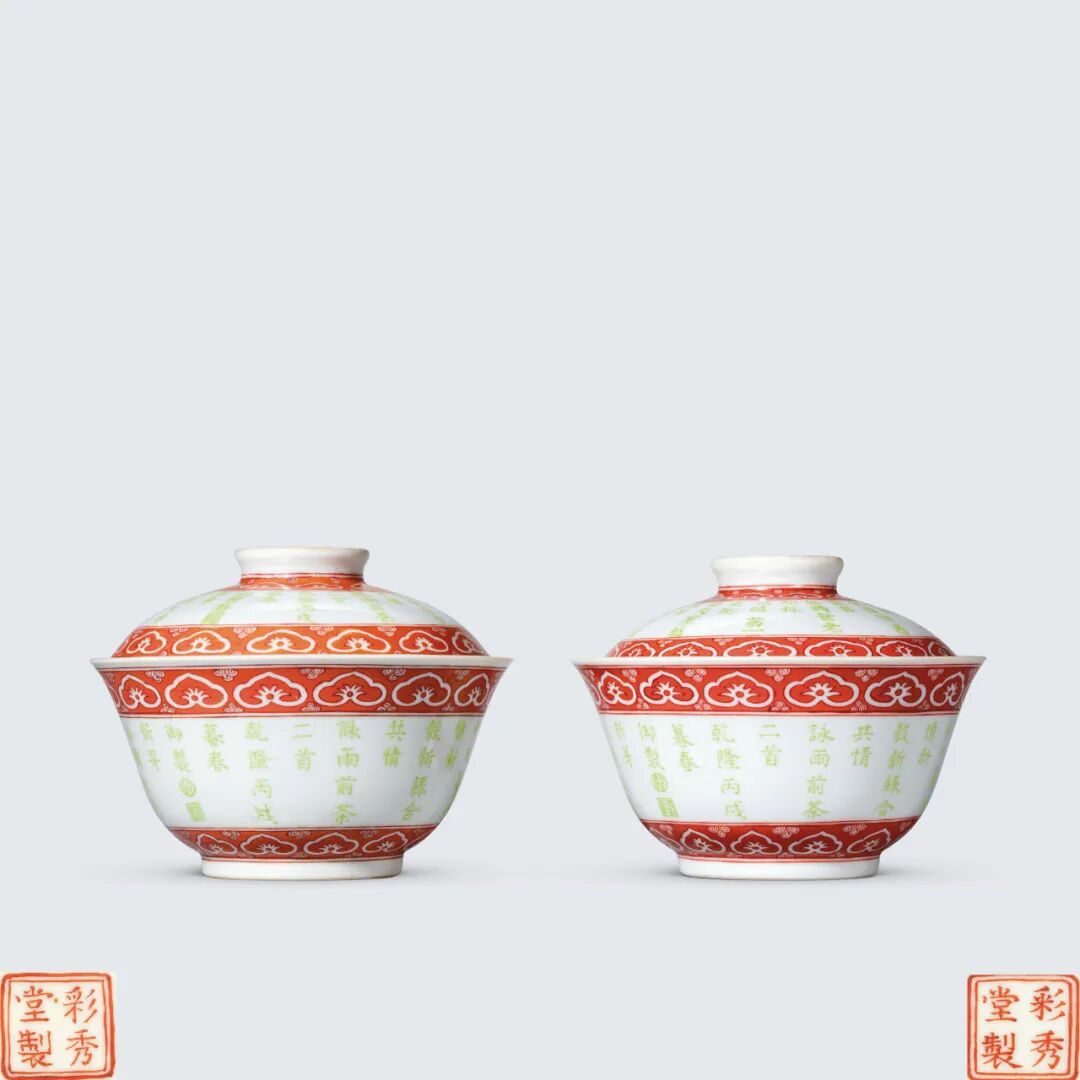
A pair of Qing Dynasty Qianlong Emperor's iron-red and green enamel covered bowls with an imperial poem on "Tea Before Rain"
The bowl is thin and light, with the inner rim and foot decorated with ruyi cloud patterns in iron-red enamel. The center of the bowl is adorned with camellia flowers, and the outer wall and lid are decorated with the same pattern. In between, the imperial poem "Pre-Rain Tea" is written in green enamel. The poem reads: "New buds and wheat grains sprout tender branches, no need for tribute riders to rush to the water station. I remember the Longjing Valley west of the lake, when old and young were busy picking tea in bamboo baskets. The first spring water is used to cook the tea, accompanied by the clear water of Yue and Xiang. I suddenly recall Nie Yizhong's words, new grains and new silk share the same feelings. Two poems on pre-rain tea. Imperial poem written in the late spring of the Bingxu year of Qianlong (1766)". It is stamped with the round and square raised seals "Qian" and "Long". The outer base and the bottom of the lid are inscribed with the four characters "Caixiutang Zhi" in iron-red double squares in two lines of regular script.
The common Sanqing tea is made in the shape of a Jiajing-era flared-rimmed teacup, and comes in both iron-red and blue-and-white varieties. It was made for the annual Sanqing tea banquet held in the Chonghua Palace during the first month of the lunar calendar. After the banquet, Emperor Qianlong would bestow the teacups upon his ministers as a reminder to maintain a pure heart like tea and to be honest and benevolent officials who love the people. This particular piece is also made in the shape of a Sanqing teacup. The imperial poem inscribed on this piece is from Volume 56 of the third collection of poems by Emperor Qianlong, titled "Tea Before Rain." The two poems describe Emperor Qianlong's reflections on the hardships of the people's labor while enjoying tea in late spring.

Poem on Tea Before Rain
This piece bears the mark "Made in Caixiutang" in iron-red enamel, while the poem on the body is written in enamel. The "Made in Caixiutang" mark appears in the Yongzheng and Qianlong reigns, and a similar mark in enamel has also been found. For example, the "Qing Dynasty Qianlong Famille Rose Bowl with Myriad Floral Pattern" sold at Christie's Hong Kong on November 29, 2024, bears the "Made in Caixiutang" mark in regular script in blue enamel. The "Qing Dynasty Yongzheng Enamel Bowl with Myriad Floral Pattern" sold at China Guardian's 2021 Spring Auction bears the "Made in the Yongzheng Reign" mark in blue enamel. Comparing these three examples, it is speculated that this piece's production is related to similar enamel-marked "Myriad Floral Pattern" wares from the Yongzheng and Qianlong periods.

A wall vase with a design of cranes paying homage in iron red and gold during the Qianlong period of the Qing Dynasty.
The vase has a wide mouth, constricted neck, angled shoulders, an arched belly, and a tapering base, resting on a flared foot pedestal resembling a wooden lotus. The entire body is decorated with iron-red enamel and gold trim. The neck is painted with a single, intertwined floral motif, the belly with a scene of cranes paying homage, and below, waves and cliffs interspersed with two clusters of lingzhi mushrooms. The depiction of the waves is particularly decorative. A total of eight cranes are depicted; four stand amidst the waves and cliffs at the bottom, while the other four soar through the sky, accompanied by flowing clouds.
In his book *Changwu Zhi* (Treatise on Superfluous Things), Wen Zhenheng of the Ming Dynasty referred to it as a "wall vase," while in the Qing Dynasty it was called a "hanging vase" or "sedan chair vase." Its primary use was for flower arranging, displayed in halls and sedan chairs as decoration. Wall vases gradually became popular during the Wanli period of the Ming Dynasty, at which time they were robust and hung in living rooms. Gao Lian of the Ming Dynasty wrote in *Zunsheng Bajian* (Eight Treatises on Following Life), Volume Seven, "Daily Life and Comfort," that "copper hooks are nailed to the back pillar of the bed to hang wall vases, arranging flowers in all four seasons, making one a companion of flowers, filling the bed with fragrance, making one feel refreshed and happy while lying down, suitable for both winter and summer." Wall vases in the Qing court were particularly favored by Emperor Qianlong, and their shapes were often ingenious, such as the monk's cap shape or the fan shape. The most common wall vases were square and round, with square and hexagonal shapes being the most frequent, while round shapes were mostly olive-shaped or gourd-shaped. The round, angled-shoulder shape of this piece is quite rare.

A wall vase with iron-red and gold-painted kui-phoenix design, featured in the "Radiant Wall Vases: Masterpieces of Chinese Wall Vases Through the Ages" exhibition at the Ningbo Museum.
Furthermore, wall vases often feature biomorphic stands, mostly imitating lacquer stands, decorated with iron-red or purple-gold glaze and gilded, and often have a base. Those imitating wood grain are relatively rare. A search of public and private collections reveals only one iron-red and gilded wall vase with a kui-phoenix design in the "Radiant Wall Vases—Exhibition of Fine Wall Vases from Chinese Dynasties" at the Ningbo Museum, whose decorative technique is quite similar to this piece. Additionally, the sea crane motif depicted on this piece likely evolved from the decoration of a pair of "Famille Rose Sea Crane Jade Ring-Shaped Vases" presented to the Qianqing Palace in 1742 (the seventh year of the Qianlong reign). The main motif of these vases also features waves, cliffs, lingzhi mushrooms, and cranes. According to the "Work Records," thirty-seven pieces were presented to the Qianqing Palace in this instance, "wearing boxes and entering first-class," indicating the recognition and fondness for this style. The use of sea cranes in this piece may have a deeper meaning, differing from the ordinary function of wall vases as "accompanying guests for recitation and gathering beauty along the way." Coincidentally, the anonymous "Pine and Crane" painting in the collection of the National Palace Museum in Taipei is also decorated with seawater, lingzhi mushrooms and cranes, and like this piece, it depicts eight cranes. The painting has the style of Que Lan and is from the same period as this piece, which may serve as evidence that this type of subject matter was popular during this period.

An anonymous painting of pines and cranes, housed in the National Palace Museum, Taipei.

Ming Xuande Imperial Cloisonné Enamel Treasure Chest with Floral Pattern Conch Shell
This Xuande cloisonné enamel conch shell was a Ming dynasty court artifact, possessing an elegant shape, thick walls, and regular form. It is decorated with a lotus scroll pattern, with branches outlined primarily by single lines and connected by curved lines to depict blooming flowers of different colors. The large flower heads, set against multi-layered petals, form a coral-like stamen at the center. The enamel is fine and clean, with pure colors and a gem-like texture, a distinctive characteristic of Xuande enamelware from the Ming dynasty.
The Xuande enamelware of the Ming Dynasty featured a variety of colors including red, yellow, blue, green, and white. The use of these colors emphasized elegance and played a pioneering role in cloisonné enamel decoration, exerting a profound influence. In Buddhism, the conch shell, as a religious symbol, carries rich spiritual connotations and profound cultural significance. Its symbolic meanings are threefold: the far-reaching dissemination of Dharma, purity and freedom from defilement, and good fortune.

Ming Xuande Imperial Cloisonné Enamel Treasure Chest with Floral Pattern Conch Shell
Cloisonné enamelware is an imported product. Based on current artifacts and historical records, it developed from the late 13th to early 14th centuries, absorbing and drawing upon the production techniques of the "Da Shi Yao" (a type of kiln) introduced to China from the Arabian Peninsula. Due to the combination of the preciousness of metal and the decorative qualities of enamel, especially its magnificent and opulent artistic effect, cloisonné enamelware was highly appreciated by feudal emperors and nobles. Both the Ming and Qing dynasties established specialized institutions within the palace (the Imperial Workshop in the Ming dynasty and the Enamel Workshop in the Qing dynasty) to produce cloisonné enamelware for imperial use.
The Imperial Workshop (御用监) of the Ming Dynasty was the official institution responsible for producing enamelware. Xuande is the earliest Ming Dynasty period to bear an official reign title. A cloisonné enamel dragon and cloud pattern jar, housed in the British Museum and a private collection in Switzerland, bears the inscription "Made in the Xuande reign of the Great Ming Dynasty, by the Imperial Workshop," clearly indicating the production location of the Xuande enamelware. Judging from surviving examples, Xuande enamelware is extremely rare, with even half a piece being incredibly difficult to find. Once it appears on the auction market, it consistently fetches high prices, making it the ultimate goal for cloisonné enamelware collectors.
Link
China Guardian 2025 Autumn Auction "Exquisite" Special Session
Preview dates: November 5-7
Guardian Customer Day, November 8th
Auction date: November 9th
Auction Location: Hall A, B1 Floor, Guardian Art Center
China Guardian 2025 Autumn Auction "Imperial Appreciation - Treasures of Ming and Qing Imperial Porcelain" Special Session
Preview dates: November 5-7
Guardian Customer Day, November 8th
Auction time: November 9th, 19:30 (postponed)
Auction Location: Hall A, B1 Floor, Guardian Art Center

